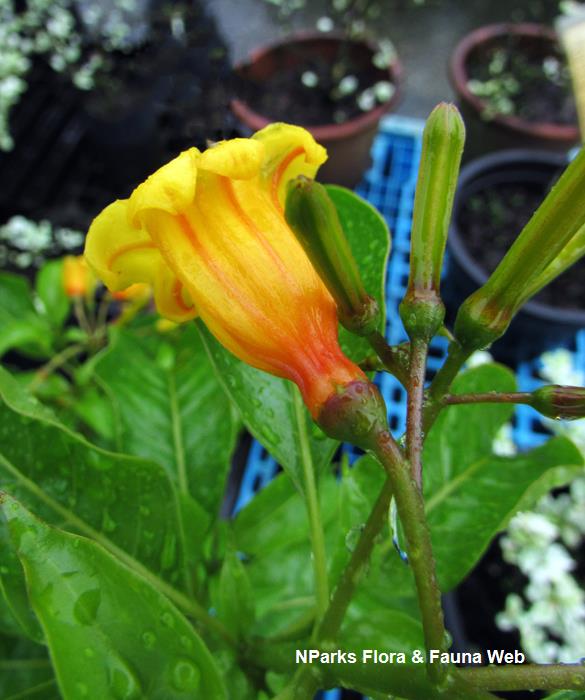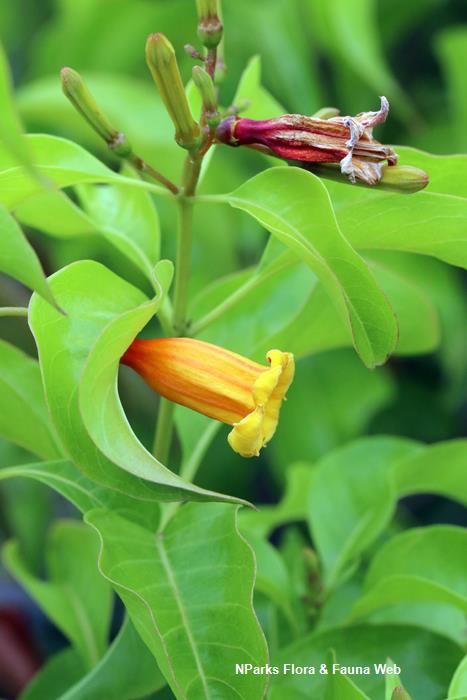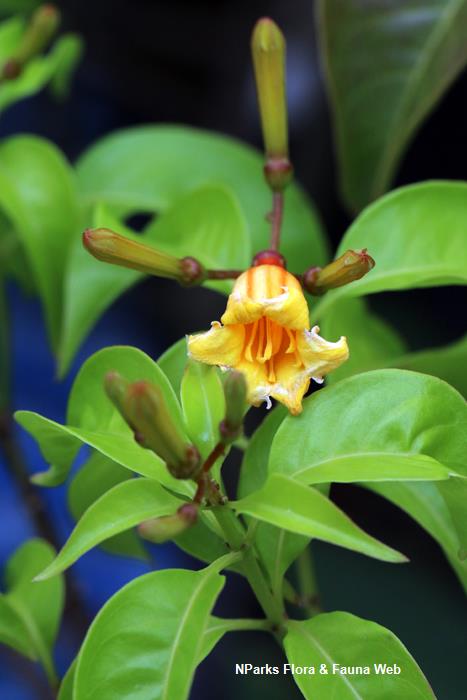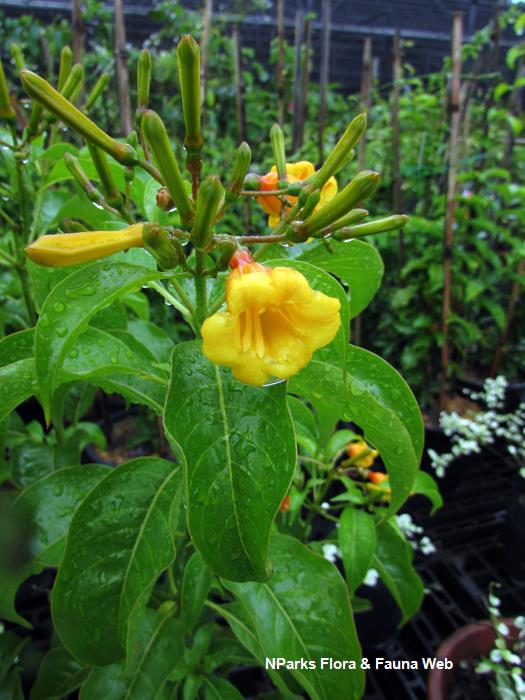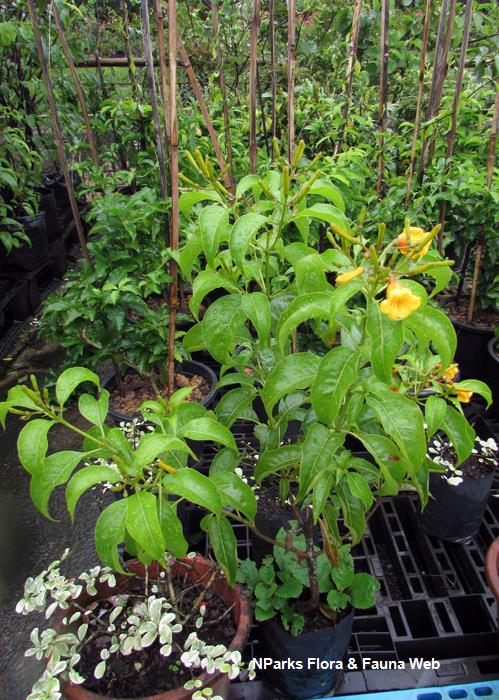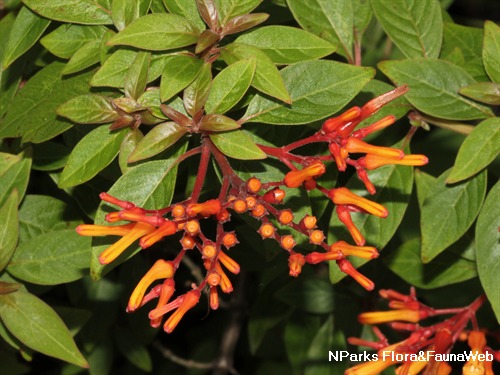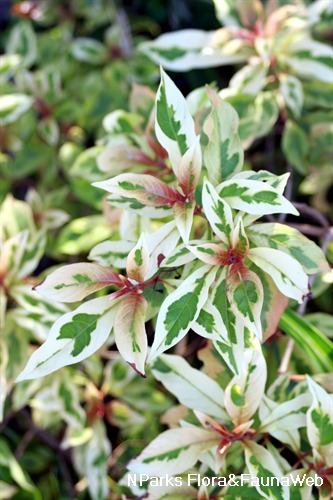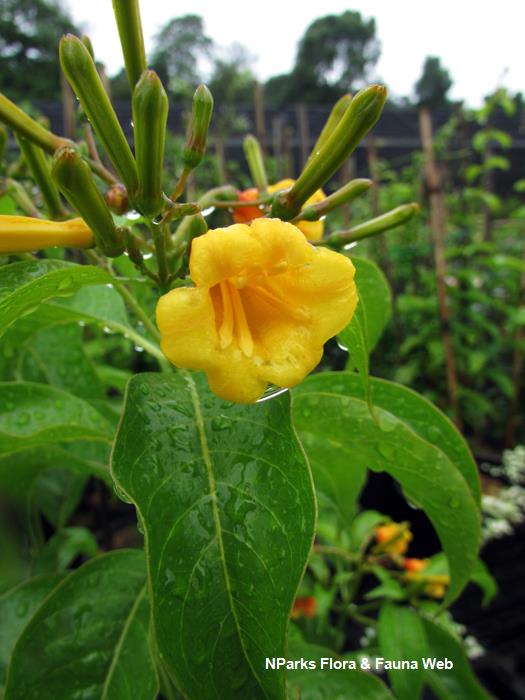
Back
Hamelia cuprea Griseb.
| Family Name: | Rubiaceae |
| Synonyms: | Hamelia cuprea var. haitiensis |
| Common Name: | Bahama Firebush, Antillean Firebush |
Although commonly known as the Bahamas Firebush, it is not from the Bahamas, but native to Cuba, Haiti, Jamaica and Grand Cayman Island. This large shrub to small tree produces bright yellow, bell-shaped flowers with red longitudinal stripes. It will help attract nectar-seeking butterflies, bees and birds to your garden.
Name
Classifications and Characteristics
| Plant Division | Angiosperms (Flowering Seed Plants) |
|---|---|
| Plant Growth Form | Shrub, Tree (Shrubby (1m-5m)) |
| Lifespan (in Singapore) | Perennial |
| Mode of Nutrition | Autotrophic |
| Maximum Height | 1.8 m to 2.4 m |
| Maximum Plant Spread / Crown Width | 1.2 m to 1.8 m |
Biogeography
| Native Distribution | Cuba, Haiti, Jamaica, Cayman Islands |
|---|---|
| Native Habitat | Terrestrial |
| Preferred Climate Zone | Sub-Tropical / Monsoonal, Tropical |
| Local Conservation Status | Non-native (Horticultural / Cultivated Only) |
| CITES Protection | False |
Description and Ethnobotany
| Growth Form | Large shrub or small tree up to 2.4 m tall. |
|---|---|
| Foliage | The light green, elliptic leaves develop a reddish to coppery tint as they mature. They are arranged in whorls of 3 leaves, where 3 leaves are connected to the stem at the same point. |
| Flowers | Bright yellow, bell-shaped flowers may have reddish longitudinal stripes. Flowers turn reddish orange at maturity. |
| Fruit | Egg-shaped berries turn reddish black at maturity. |
| Cultivation | The plant grows best under full sun in well-drained soil. Keep the soil moist when the plant is young, but it becomes drought tolerant after establishing itself. |
| Etymology | The specific epithet 'cuprea' means copper and refers to the coppery, reddish tint of the leaves. |
Landscaping Features
| Landscaping | The large leaves of Bahama Firebush are ideal for screening, but it is better to prune it naturally to promote more flowering (as opposed to a traditional hedge shape). |
|---|---|
| Desirable Plant Features | Ornamental Flowers |
| Landscape Uses | Container Planting, Hedge / Screening |
| Thematic Landscaping | Butterfly Garden, Golden Garden |
Fauna, Pollination and Dispersal
| Fauna Pollination Dispersal Associated Fauna | Butterfly-Attracting (Flower Nectar) |
|---|---|
| Pollination Method(s) | Biotic (Fauna) (Insects (Butterfly, Moth), Insects (Bee), Vertebrates (Bird)) |
Plant Care and Propagation
| Light Preference | Full Sun |
|---|---|
| Water Preference | Moderate Water |
| Plant Growth Rate | Moderate |
| Rootzone Tolerance | Drought Tolerant |
| Potential Problems | It might be attacked by spider mites, scale insects, aphids and caterpillars. |
Foliar
| Foliage Retention | Deciduous |
|---|---|
| Mature Foliage Colour(s) | Green - Light Green, Green |
| Mature Foliage Texture(s) | Glossy / Shiny |
| Prominent Young Flush Colour(s) | Green - Light Green |
| Foliar Type | Simple / Unifoliate |
| Foliar Arrangement Along Stem | Whorled |
| Foliar Attachment to Stem | Petiolate |
| Foliar Shape(s) | |
| Foliar Venation | Pinnate / Net |
| Foliar Margin | Entire - Wavy / Undulate |
| Foliar Apex - Tip | Acute |
| Foliar Base | Acute |
| Typical Foliar Area | Notophyll ( 20.25cm2 - 45 cm2 ) |
| Mature Foliage Colour(s) Remarks | Mature leaves may be coppery. |
| Typical Foliar Size | 7.5 cm |
Floral (Angiosperm)
| Flower Colour(s) | Yellow / Golden, Red, Orange |
|---|---|
| Flower Grouping | Cluster / Inflorescence |
| Flower Location | Terminal |
| Flower Symmetry | Radial |
| Individual Flower Shape | Campaulate / Bell-shaped |
| Flower Transitional Changes | Colour |
| Flower Size | 3.5 cm x 2 cm |
Fruit, Seed and Spore
| Mature Fruit Colour(s) | Black |
|---|---|
| Fruit Classification | Simple Fruit |
| Fruit Type | Fleshy Fruit , Berry |
Image Repository
Others
| Master ID | 33230 |
|---|---|
| Species ID | 7644 |
| Flora Disclaimer | The information in this website has been compiled from reliable sources, such as reference works on medicinal plants. It is not a substitute for medical advice or treatment and NParks does not purport to provide any medical advice. Readers should always consult his/her physician before using or consuming a plant for medicinal purposes. |

